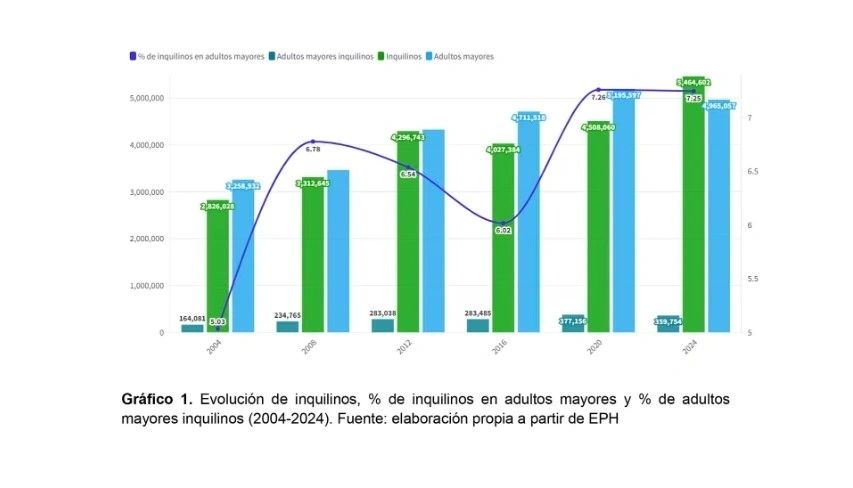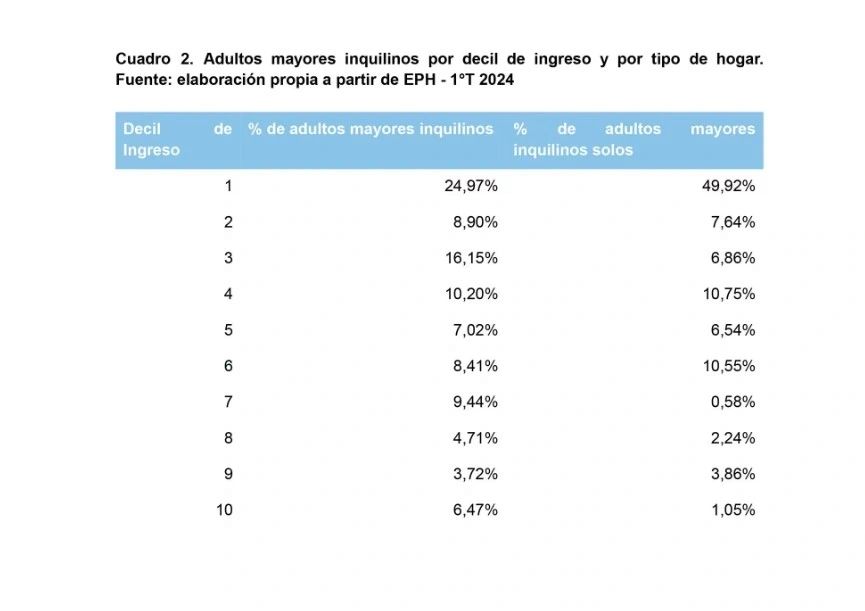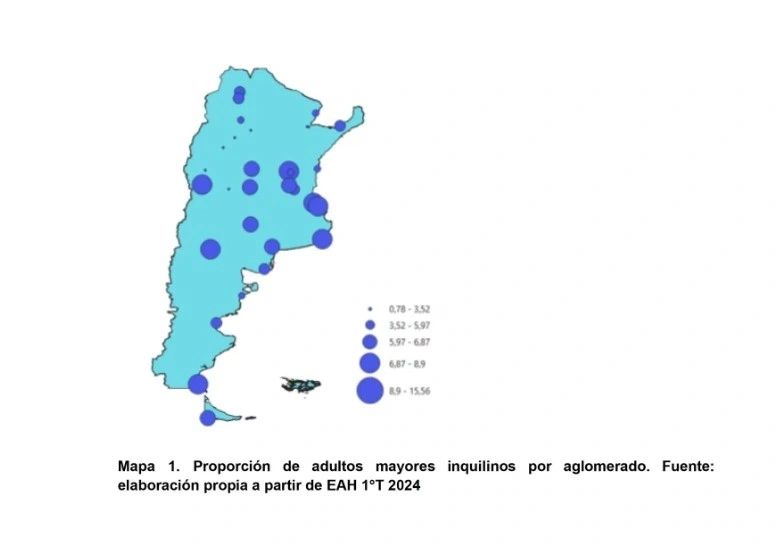“Tenancy”: the number of seniors renting in Argentina has doubled in 20 years - Infobae

Source:

 www.infobae.com
www.infobae.com
October 14, 2024
“Tenancy”: the number of seniors renting in Argentina has doubled in 20 years
This is according to a private report based on official data. More than 359,000 older adults need to rent a property to live in, more than double the number in 2004, when there were just over 164,000. Causes of the phenomenon, most affected localities and why it is so difficult to access own housing
By Jose Luis Cieri

It is not only young people who have problems accessing their own homes; older adults also face adverse situations in times of consecutive economic crises (Illustrative Image Infobae)
In Argentina, access to housing has become a difficult challenge to overcome for all age groups, including older adults, who face significant obstacles in acquiring property.
According to a recent report by the Tejido Urbano Foundation, more than 359,000 older adults in the country resort to renting to be able to live in a home, more than double the number from 20 years ago. This phenomenon, known as “tenancy,” reflects a housing problem that is compounded by others, such as health coverage and economic difficulties aggravated by various crises and salaries far below what a family needs to live with dignity.
The report, based on data from the Permanent Household Survey (EPH), revealed that 7.25% of the population over 60 years of age in Argentina lives in rented accommodation, representing 6.58% of the total number of tenants nationwide.
The increase in the number of older adults renting is closely related to the difficulties in accessing property (lack of mortgage loans, which, although reintroduced this year, are not easy to obtain for those over 60), a trend that worsened after the economic crisis of 2001.

Since then, housing policies and socioeconomic conditions have made it difficult for a large part of the population to access their own home. Among older adults, renting reflects lives marked by job instability, precarious employment and falling wages, which prevented them from accessing property.
Matías Araujo , a researcher at the Tejido Urbano Foundation, told Infobae that the situation of older tenants is especially delicate. “In addition to economic vulnerability, they face greater problems in securing stable and accessible housing. The increase in tenants in this group not only shows the lack of access to property, but also the permanence of precarious forms of tenure, such as irregular occupation or housing in poor neighborhoods,” he said.
The city of Buenos Aires has the highest proportion of older adults living as renters, followed by cities such as La Plata, Santa Fe, Neuquén, Mendoza and Río Gallegos. This pattern is linked to historical processes of internal migration that drove urban growth in past decades. This process in developed cities responds to economic, social and migratory factors.
This phenomenon accompanied social changes such as increased life expectancy and women's autonomy, creating new profiles of tenants. "Those who did not have access to property during their working life remain renting until old age, facing greater economic vulnerability and limitations in stability and quality of life," explained Araujo.
Cities with better infrastructure in health, transportation and recreational services offer a higher quality of life for older adults. In contrast, in places like Tucumán or Santiago del Estero, the lack of a consolidated rental market pushes them into more precarious forms of housing.
In more developed cities like Buenos Aires and La Plata, the high cost of housing and the lack of social networks kept many migrants as renters for years. Araujo, from the Tejido Urbano Foundation, points out that external migrants face even more difficulties in accessing property, which leaves them in a vulnerable situation in old age.

40.52% of older adults living alone are in the first income decile (that is, they are part of the poorest 10% of society, by income level), and 72.7% are in the first four (poorest 40%). In addition, 18% do not receive a pension for continuing to work, while those who do receive a pension depend on it as their main source of support.
Rent is a heavy burden for seniors, whose monthly income ranges from $135,000 to $276,500. After paying rent, the economic margin to meet basic needs such as food and medicine is very small. The Basic Food Basket for a senior varies between $62,000 and $96,000, depending on gender, which leaves little room for unexpected expenses.
According to Inquilinos Agrupados, the Total Basic Tenant Basket (CBTI) for September 2024 showed an increase of 6.1% for single-person households, 5.7% for couples, and 5.3% for families of four compared to August. The values were $765,963 for a single-person household, $1,226,854 for a couple, and $1,742,877 for a family of four.
Araujo added: “The lack of coordination between the different levels of the State aggravates the problem. Cities with high rates of elderly tenants, such as Buenos Aires, require specific policies that not only offer shelter, but housing adapted to their physical and economic conditions.”

It is necessary to develop a housing policy focused on old age, which addresses not only housing, but also issues such as loneliness, mobility and economic precariousness. “Cooperation between national and provincial governments is key to achieving a comprehensive solution,” he said.
After paying rent, older adults have little time left to cover basic needs such as food and health, affecting their quality of life. This highlights the urgent need for comprehensive housing policies that go beyond pensions and medical coverage.
Local governments must take on a key role, especially in areas with a high concentration of older adult tenants, such as CABA. Strategies are needed that involve retirement centers, promote intergenerational coexistence, and strengthen rental programs and adapted housing.
Araujo concluded: “It is vital that governments and civil society collaborate to create adequate housing opportunities for older adults, combining accessible credit, housing improvements and control over the conditions of the most vulnerable.”
www.buysellba.com

Source:

“Inquilinización”: en 20 años se duplicó la cantidad de adultos mayores que alquilan en la Argentina
Así precisa un informe privado, basado en datos oficiales. Más de 359.000 adultos mayores necesitan alquilar una propiedad donde vivir, más del doble que en 2004, cuando eran poco más de 164.000. Causas del fenómeno, localidades más afectadas y por qué es tan difícil acceder a la vivienda propia
October 14, 2024
“Tenancy”: the number of seniors renting in Argentina has doubled in 20 years
This is according to a private report based on official data. More than 359,000 older adults need to rent a property to live in, more than double the number in 2004, when there were just over 164,000. Causes of the phenomenon, most affected localities and why it is so difficult to access own housing
By Jose Luis Cieri

It is not only young people who have problems accessing their own homes; older adults also face adverse situations in times of consecutive economic crises (Illustrative Image Infobae)
In Argentina, access to housing has become a difficult challenge to overcome for all age groups, including older adults, who face significant obstacles in acquiring property.
According to a recent report by the Tejido Urbano Foundation, more than 359,000 older adults in the country resort to renting to be able to live in a home, more than double the number from 20 years ago. This phenomenon, known as “tenancy,” reflects a housing problem that is compounded by others, such as health coverage and economic difficulties aggravated by various crises and salaries far below what a family needs to live with dignity.
The report, based on data from the Permanent Household Survey (EPH), revealed that 7.25% of the population over 60 years of age in Argentina lives in rented accommodation, representing 6.58% of the total number of tenants nationwide.
The increase in the number of older adults renting is closely related to the difficulties in accessing property (lack of mortgage loans, which, although reintroduced this year, are not easy to obtain for those over 60), a trend that worsened after the economic crisis of 2001.

Since then, housing policies and socioeconomic conditions have made it difficult for a large part of the population to access their own home. Among older adults, renting reflects lives marked by job instability, precarious employment and falling wages, which prevented them from accessing property.
Matías Araujo , a researcher at the Tejido Urbano Foundation, told Infobae that the situation of older tenants is especially delicate. “In addition to economic vulnerability, they face greater problems in securing stable and accessible housing. The increase in tenants in this group not only shows the lack of access to property, but also the permanence of precarious forms of tenure, such as irregular occupation or housing in poor neighborhoods,” he said.
The city of Buenos Aires has the highest proportion of older adults living as renters, followed by cities such as La Plata, Santa Fe, Neuquén, Mendoza and Río Gallegos. This pattern is linked to historical processes of internal migration that drove urban growth in past decades. This process in developed cities responds to economic, social and migratory factors.
Over the last 20 years, the growth of these cities has consolidated a rental market that absorbs the greatest demand, although in a segmented manner, especially due to internal and external migration in search of better opportunities.
This phenomenon accompanied social changes such as increased life expectancy and women's autonomy, creating new profiles of tenants. "Those who did not have access to property during their working life remain renting until old age, facing greater economic vulnerability and limitations in stability and quality of life," explained Araujo.
Cities with better infrastructure in health, transportation and recreational services offer a higher quality of life for older adults. In contrast, in places like Tucumán or Santiago del Estero, the lack of a consolidated rental market pushes them into more precarious forms of housing.
Surprising data
More than 33% of older adult tenants were born in another province or country, migrating in search of better opportunities, but without achieving access to their own home. In regions such as Corrientes, Catamarca or Santiago del Estero, many live in irregular conditions without access to basic services.In more developed cities like Buenos Aires and La Plata, the high cost of housing and the lack of social networks kept many migrants as renters for years. Araujo, from the Tejido Urbano Foundation, points out that external migrants face even more difficulties in accessing property, which leaves them in a vulnerable situation in old age.

40.52% of older adults living alone are in the first income decile (that is, they are part of the poorest 10% of society, by income level), and 72.7% are in the first four (poorest 40%). In addition, 18% do not receive a pension for continuing to work, while those who do receive a pension depend on it as their main source of support.
Rent is a heavy burden for seniors, whose monthly income ranges from $135,000 to $276,500. After paying rent, the economic margin to meet basic needs such as food and medicine is very small. The Basic Food Basket for a senior varies between $62,000 and $96,000, depending on gender, which leaves little room for unexpected expenses.
According to Inquilinos Agrupados, the Total Basic Tenant Basket (CBTI) for September 2024 showed an increase of 6.1% for single-person households, 5.7% for couples, and 5.3% for families of four compared to August. The values were $765,963 for a single-person household, $1,226,854 for a couple, and $1,742,877 for a family of four.
Deterioration
Current policies do not comprehensively address the housing needs of older adults. Although there are subsidies and programs, such as those of PAMI between 2016 and 2019, these only reached a small part of the vulnerable population.Araujo added: “The lack of coordination between the different levels of the State aggravates the problem. Cities with high rates of elderly tenants, such as Buenos Aires, require specific policies that not only offer shelter, but housing adapted to their physical and economic conditions.”

It is necessary to develop a housing policy focused on old age, which addresses not only housing, but also issues such as loneliness, mobility and economic precariousness. “Cooperation between national and provincial governments is key to achieving a comprehensive solution,” he said.
The key role of local governments
With rents on the rise, “it is critical to ask ourselves what percentage of senior renters’ income goes toward housing and, above all, what type of housing they can afford,” Araujo said.After paying rent, older adults have little time left to cover basic needs such as food and health, affecting their quality of life. This highlights the urgent need for comprehensive housing policies that go beyond pensions and medical coverage.
Local governments must take on a key role, especially in areas with a high concentration of older adult tenants, such as CABA. Strategies are needed that involve retirement centers, promote intergenerational coexistence, and strengthen rental programs and adapted housing.
Araujo concluded: “It is vital that governments and civil society collaborate to create adequate housing opportunities for older adults, combining accessible credit, housing improvements and control over the conditions of the most vulnerable.”
www.buysellba.com

